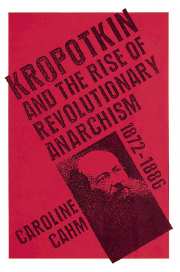Book contents
- Frontmatter
- Contents
- Preface
- Acknowledgements
- Introduction
- Part I Kropotkin and the development of the theory of anarchist communism
- Part II Kropotkin and the development of anarchist ideas of revolutionary action by individuals and small groups (1872–1886)
- 3 Revolutionary action and the emergent anarchist movement of the seventies
- 4 Propaganda by deed: the development of the idea
- 5 Kropotkin and propaganda by deed
- 6 Kropotkin and acts of revolt
- 7 The Congress of London 1881 and ‘The Spirit of Revolt’
- 8 The trial of Lyon 1883 and response to persecution
- Part III Kropotkin and the development of anarchist views of collective revolutionary action (1872–1886)
- Conclusion
- Notes
- Bibliography
- Index
8 - The trial of Lyon 1883 and response to persecution
Published online by Cambridge University Press: 14 September 2009
- Frontmatter
- Contents
- Preface
- Acknowledgements
- Introduction
- Part I Kropotkin and the development of the theory of anarchist communism
- Part II Kropotkin and the development of anarchist ideas of revolutionary action by individuals and small groups (1872–1886)
- 3 Revolutionary action and the emergent anarchist movement of the seventies
- 4 Propaganda by deed: the development of the idea
- 5 Kropotkin and propaganda by deed
- 6 Kropotkin and acts of revolt
- 7 The Congress of London 1881 and ‘The Spirit of Revolt’
- 8 The trial of Lyon 1883 and response to persecution
- Part III Kropotkin and the development of anarchist views of collective revolutionary action (1872–1886)
- Conclusion
- Notes
- Bibliography
- Index
Summary
The spring and summer of 1882 were marked by dramatic developments in France which created great excitement in the Lyonnais movement. And it was this that finally persuaded Kropotkin to return. In February, the Lyon anarchists had launched a newspaper, Le Droit Social, which, under various names in the next few years, was to provide a lively and provocative focal point for the small but remarkably resilient movement of the region.
On 23 March a strike at Roanne of 4,000 weavers involving a lockout had ended with some workers not being taken back on. The next day a young unemployed worker called Fournier shot at Bréchard, the employer believed to be the instigator of the crisis. The anarchists of the Lyon region reacted enthusiastically to this attentat with Dejoux, the editor of the Droit Social, organising a subscription to buy a ‘revolver d'honneur’ for its perpetrator. Meanwhile at the end of February, Emile Florian, a young cotton worker from Reims who in October 1881 had shot at the first bourgeois he saw after failing to get near enough to Gambetta to kill him, had been sentenced to twenty years hard labour, and the anarchists in Paris had organised two meetings and made collections on his behalf. Anarchists in the Lyon region were quick to follow the example of their Parisian comrades and they organised meetings at Reims and Roanne which acclaimed both Florian and Fournier as ‘Présidents d'honneur’.
- Type
- Chapter
- Information
- KropotkinAnd the Rise of Revolutionary Anarchism, 1872-1886, pp. 178 - 210Publisher: Cambridge University PressPrint publication year: 1989



